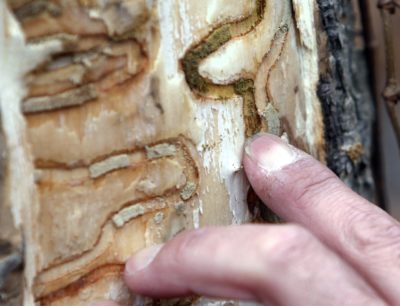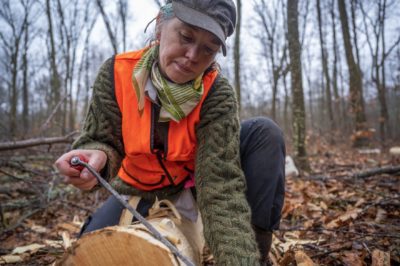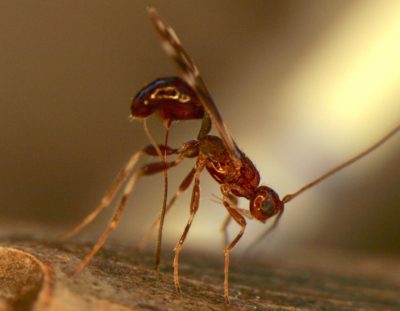The tree Radka Wildova and Jonathan Rosenthal wanted to show me was only a few hundred feet from the trail at Tivoli Bays, a state wildlife management area in Rhinebeck, New York. But getting to it required bushwhacking through a thicket of non-native honeysuckle, multiflora rose, and poison ivy. “It’s like a museum of invasives here,” Rosenthal, an ecologist based in nearby New Paltz, observed as we stumbled through the underbrush.
The tree, once reached, was maybe a hundred feet high and ten inches in diameter. It was sporting a metal tag that identified it as number 047. “This is a green ash,” Wildova, a botanist who’s also based in New Paltz (and is Rosenthal’s wife) announced. Ash trees are dioecious, meaning they produce either all male or all female flowers.
“I think it’s a she,“ Wildova said. “But they don’t flower every year, so it can be hard to tell.”
What was distinctive about tree number 047 was that it was alive, or at least mostly so. Since emerald ash borer beetles were first introduced to the United States, probably in the 1990s, hundreds of millions of trees have died. In the Hudson Valley, the vast majority of ash have succumbed.
One day, scientists hope, borer-resistant trees will provide seeds to replace some of the millions of ash that have been lost.
But a very small proportion of ash trees — maybe 1 percent — seem to be resisting the beetles. These have become known as “lingering ashes,” and Wildova and Rosenthal routinely brave poison ivy for them.
The two run a program called Monitoring and Managing Ash, which goes by the acronym MaMA. (“Our tagline is ‘Come to MaMA,’” Rosenthal joked to me.) The program trains state and local officials and interested citizens how to identify lingering ashes and also collects samples from resistant trees.
Over the winter, Wildova recounted, she had clambered out to number 047 carrying a pruning saw attached to a long pole. With the saw, she had cut a small branch from the tree. “You have to do it when the trees are dormant,” she explained.
The branch had been sent out to be grafted onto ash root stock to grow a new baby tree, which had then been sent to a greenhouse at Cornell University. When the tree is old enough to produce flowers — female ones, presumably — it will be crossed with another lingering ash to produce trees that, it is hoped, will be even more resistant to emerald ash borers than its parents. One day — so the hope further goes — these resistant trees will provide seeds to replace some of the millions of ash that have been lost. A similar effort has been underway for several years at the U.S. Department of Agriculture’s research station in Delaware, Ohio. Some of the trees in Ohio are now being field-tested. (Since ash trees are regionally adapted, it won’t be enough to develop one variety of E.A.B.-resistant ash; many varieties will be needed.)
Left: Researchers Jonathan Rosenthal and Radka Wildova. Right: “Lingering ash” number 047 in Tivoli Bays wildlife management area in New York.
Radka Wildova; Jerry Monkman / EcoPhotography
“There are five stages of grief, and one of them is resignation, which it seems like a huge number of people are at,” Rosenthal said. “People will say, ‘These trees are disappearing,’ and they’ll write them off. So we’ve found that the best way to engage with them and get them actually to do something, is to let them know that there is hope and there are things that can be done.”
Emerald ash borers, or E.A.B.’s as they are often called, are about half an inch long with shimmering green wings. The beetles, which are native to China, Korea, and eastern Russia, likely were introduced to the U.S. through infected shipping crates or wooden pallets. They were first detected in Michigan in 2002 and by now have spread throughout the Midwest, New England, the Mid-Atlantic states, and much of the Southeast. In 2022, the first population was detected on the West Coast, in Oregon.
Ash are a crucial component of Eastern forests; in places like north-central Vermont, they make up more than a quarter of the tree canopy. The trees’ seeds are an important food source for birds and small mammals, and their leaves decompose more quickly than those of trees like oak, so they are key to nutrient recycling. Dozens of insect species depend on ash, and hundreds are associated with ash trees. If these trees are lost, creatures that rely on them could very well be driven to extinction.
According to a recent paper, the emerald ash borer is “the most destructive and costly invasive forest insect” North America has seen.
“There is no rescue island,” is how David Wagner, a professor of ecology and evolutionary biology at the University of Connecticut, has put it. According to a recent paper by researchers at the U.S. Army Corps of Engineers, E.A.B. is “the most destructive and costly invasive forest insect” North America has seen.
Ash, meanwhile, is not just one tree, but a whole group of them. (Curiously enough, no one knows exactly how many species of ash there are in North America; estimates run from 15 to 25.) Most species seem to be vulnerable to E.A.B., including green ash, white ash, and black ash, each of which is significant for different reasons, ecological and cultural.
Green ash are fast-growing and pollution-tolerant. As a result, they were often planted in urban settings after Dutch elm disease swept through. (It’s been estimated that removing and replacing urban ash trees could end up costing cities more than $12 billion.) White ash is one of the few native trees species that’s capable of growing up through the thicket of non-native plants that now forms the understory in many Eastern forests. So without them, more forests may become “museums of invasives.” For most of baseball history, bats were made of white ash. (Now wood bats are mainly made from maple.)

Tunnels carved by emerald ash borer larvae beneath the bark of an ash tree.
Mike Groll / AP Photo
Black ash live in swamps and play a key role in their habitat’s hydrology; when the ash die, the swamps may turn to open water. Black ash is also central to many Indigenous cultures; its wood has special properties that make it prized by basket-makers. According to one of their creation stories, the Wabanaki people, whose territory once included much of New England and southeastern Canada, emerged from an arrow shot into a black ash tree.
For all these reasons, E.A.B. would on its own count as an ecological disaster. But in its assault on Eastern forests, it has plenty of company. American chestnut trees were more or less wiped out in in the first half of the 20th century by chestnut blight, a fungal pathogen introduced from Asia. (Infected trees were first noticed at the Bronx Zoo in 1904.) Dutch elm disease, another fungal pathogen, killed off most of the U.S.’s elm trees in the middle part of the last century. (Despite the name, Dutch elm disease probably also came from Asia.) Eastern hemlocks are now at risk from woolly adelgid, insects introduced from Japan, while beech trees are threatened by beech bark disease, caused by an insect, and also by beech leaf disease, caused by a nematode.
“These trees are being pulled right out of the forest by these forest pests and pathogens,” Leigh Greenwood, director of The Nature Conservancy’s Forest Pest and Pathogen Program, said. “In some places, you get native tree regrowth that provides relatively good compensation, though you’re still missing the biodiversity. But in other places, you don’t get good compensation, and then the whole ecology starts to collapse on itself.”
Invasive pests do well because they’ve left their predators behind. One way to fight them is to import their pests to pester them.
Recently, The Nature Conservancy announced a new initiative, “Trees in Peril,” aimed at accelerating efforts to breed resistant ash, elms, hemlocks, and beeches. Among the groups that have received funding from the initiative, which is supported by a $4.7 million grant from the New York-based Manton Foundation, are MaMA and the ash breeding program at Cornell. The project will also finance masters, PhD, and postdoctoral positions for specialists who can carry on the breeding project, which, it’s expected, will take decades.
“This is generational work for the humans as well as the trees,” she said.
Invasive pests often do well because they’ve left their predators behind. One way to fight them — a method called biocontrol — is to import their pests to pester them. On a separate track, scientists are working to help ash by spreading insects that kill E.A.B.
On a beautiful day not long ago, I joined Claire Rutledge, an entomologist with the Connecticut Agricultural Experiment Station, to monitor the results of some of these efforts. We met up at a farm in Kent, Connecticut. Rutledge had marked the ash trees she wanted to check with orange tape.

Entomologist Claire Rutledge cuts bark from an ash tree in search of emerald ash borer larvae.
Tyler Russell / Connecticut Public
As soon as the dangers of E.A.B. were recognized, researchers with the U.S. Department of Agriculture went looking for the beetles’ natural enemies. They found three of them in northeast China — all parasitic wasps. One of the wasps didn’t do well in the cold, so the researchers went to Russia to find a hardier species. Many biocontrol efforts have gone awry, so the wasps underwent rigorous testing to make sure they did not also attack native insects. At the conclusion of this testing, the E.A.B. predators were released at hundreds of sites in the Midwest and the Northeast, including several in western Connecticut. Many of the introductions were successful enough that the wasps have multiplied and spread. (The wasps still could cause damage the researchers did not anticipate; unfortunately, this is very difficult to monitor and, once the wasps have established themselves, even more difficult to do anything about.)
At the farm in Kent, Rutledge was checking to make sure the populations had survived the winter and were reproducing. The taped trees were all still alive, though not for long. An assistant of Rutledge’s cut down one with a chainsaw; it was about 40 feet high and maybe six inches in diameter. Rutledge began slicing away at its bark with a two-handled drawknife. “This is a pretty infected tree,” she said.

A parasitic wasp, Spathius galinae, probes ash bark for emerald ash borer larvae.
Jian Duan / USDA
Female emerald ash borers lay their eggs on the bark of ash trees. When these hatch, the larvae bore through the bark and start consuming the vascular tissue underneath. As they eat their way along, the larvae form tunnels that run up the side of the tree in a series of switchback-like curves. An ash may be able to survive a few of these tunnels, but enough of them disrupts the flow of nutrients and the tree dies. Rutledge was excited to find a clutch of wasp cocoons in one of the tunnels she sliced through. “Cool,” she said.
The cocoons, from the species Spathius galinae, looked like tiny grains of rice. Rutledge explained that the wasps’ mother had deposited her eggs inside an E.A.B. larva. When these eggs had hatched, the wasp larvae had then eaten their way through the beetle larva, killing it. They had now pupated, and, had they been left alone, would have emerged as adult wasps.
More slicing yielded a E.A.B. larva in its third instar, meaning it had molted twice. At this stage, the larva was probably safe from predation. “This is a third and it looks perfectly happy, unfortunately,” Rutledge said.
When beetle numbers are high, the introduced wasps are no match for E.A.B. The hope is that as mature ash trees die and beetle numbers decline, the introduced wasps will keep the E.A.B. population low enough that even non-resistant saplings will be able to survive. Growing a mature ash is a slow process, though, so it will be decades before it’s clear whether this hope will be realized.
In the meantime, unfortunately, additional threats to Eastern forests are sure to emerge. Just a few years ago, a new imported pest, the elm zigzag sawfly, was detected in Virginia; it’s now in at least four more states: Maryland, Pennsylvania, North Carolina, and New York. As the website Entomology Today put it in a post on the sawfly: “Here We Go Again.”






